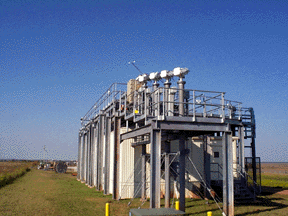 SGP Radiometric Calibration Facility
SGP Radiometric Calibration Facility

The Radiometric Calibration Facility (RCF) provides shortwave radiometer calibrations traceable to the World Radiometric Reference. Electrically self-calibrating, absolute cavity radiometers are used to calibrate pyrheliometers and pyranometers for measuring the direct normal (or "Beam") and total hemispheric (or "Global") shortwave irradiances respectively. The calibration of longwave radiometers are based on exposures to temperature-controlled blackbodies and outdoor comparisons with standard pyrgeometers.
The ARM Program requires accurate measurements of solar radiation from radiometers used in ground-based networks and airborne instrument platforms. These measurements are needed to improve the mathematical description of radiative transfer processes simulated in global circulation models used to predict climate change. For example, evaluations of the so-called "excess absorption" by clouds and radiative transfer models for clear skies are highly dependent on accurate surface measurements of downwelling solar radiation. The ARM program has acquired more than 100 pyranometers and pyrheliometers for measuring shortwave solar irradiance. The data quality of the measurements from these radiometers requires accurate and regular recalibration traceable to the World Radiometric Reference, the international standard of solar radiation measurement. Understanding the total atmospheric energy balance requires the measurement of longwave (thermal) radiation in addition to monitoring the shortwave (solar) portion of the energy spectrum.
The ARM Pyrgeometer Blackbody Calibration System was installed at the RCF in April 2002. The new system provides pyrgeometer calibrations consistent with the WMO's Baseline Surface Radiation Network (BSRN) calibration protocol. This will complement the BORCAL procedure for calibrating the broadband shortwave radiometers.
Primary Measurements Taken
During shortwave radiometer calibration periods under clear-sky conditions, the following solar irradiance components are measured on a 30-second interval:
Direct normal ("beam") solar irradiance, (Watts/square meter)
Diffuse horizontal ("sky") solar irradiance, (Watts/square meter)
Radiometer body temperature, (Degrees Celsius)
Pyrgeometer dome temperature, (Degrees Celsius)
Air temperature near calibration tables, (Degrees Celsius)
Relative Humidity near calibration tables, (Percent)
Theory of Operation
Shortwave radiometer calibrations are accomplished using the Summation Technique.
Calibration and Theory
Certain standards are used frequently to calibrate radiometers deployed in continuous monitoring stations. The World Radiometric Reference (WRR) is the internationally recognized standard for solar (shortwave) irradiance measurement. A group of seven self-calibrating absolute cavity radiometers form its basis. Reference standard radiometers from around the world are compared every five years to the WRR at the World Radiation Center in Switzerland. By participating in these comparisons, the ARM Program Reference Standard Radiometer has direct traceability to the WRR. Annually, this reference standard is compared with other cavity radiometers used at the Department laboratories, the National Oceanic and Atmospheric Administration (NOAA), and private industry to transfer the calibration to so-called working standards.
Instrument calibration is the first step in proper data quality control. The RCF is designed to simultaneously calibrate up to 100 radiometers in outdoor conditions similar to those the field instruments would experience in routine monitoring. Instruments calibrated at the site include 1) pyrheliometers, which are used to measure direct (beam) solar irradiance; 2) pyranometers, which have a hemispheric (fish-eye) field of view and are designed to measure the total direct and diffuse (sky) irradiance on a flat surface; and 3) pyrgeometers, which are similar to pyranometers, but have an outer blocking filter to eliminate the high energy solar irradiance and measure only the longwave, thermal (or infrared) radiation from the atmosphere.
Pyrgeometers are calibrated in special, temperature-controlled blackbody chambers. In the fall of 1999, the ARM Program hosted the First International Pyrgeometer and Absolute Scanning Radiometer Comparison (IPASRC-1). This initiative of the World Meteorological Organization Global Climate Research Program's Baseline Surface Radiation Network community used side-by-side nighttime comparisons at the RCF to calibrate 15 pyrgeometers. Complex energy exchanges between the sun and the earth's ocean, land, and atmosphere provide a balance that makes up our climate. Accurate radiation measurements are essential for improving our understanding of this balance.



